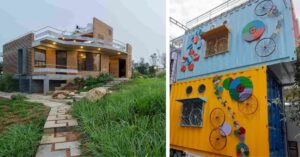8 Unique Sustainable Homes Show How to Reduce Electricity & Water Bills Significantly
Looking for ways to cut down electricity and water bills? Here is a list of houses across the country that use innovative methods to be energy-efficient and reduce wastage.

There’s often a misconception that building a sustainable or greener home comes with a lot of risks and compromises on comfort. But this is far from true as today with several unique innovations and techniques people are opting for spaces that complement their surroundings.
By harvesting solar energy or rainwater or by using several passive ventilation and solar methods, now one can make their home more energy-efficient, reduce wastage and cut down on bills.
So, here’s a list of eight houses across the country that use several unique methods to save on electricity and water bills:
1. A unique house in Amreli generates zero bills for water & power
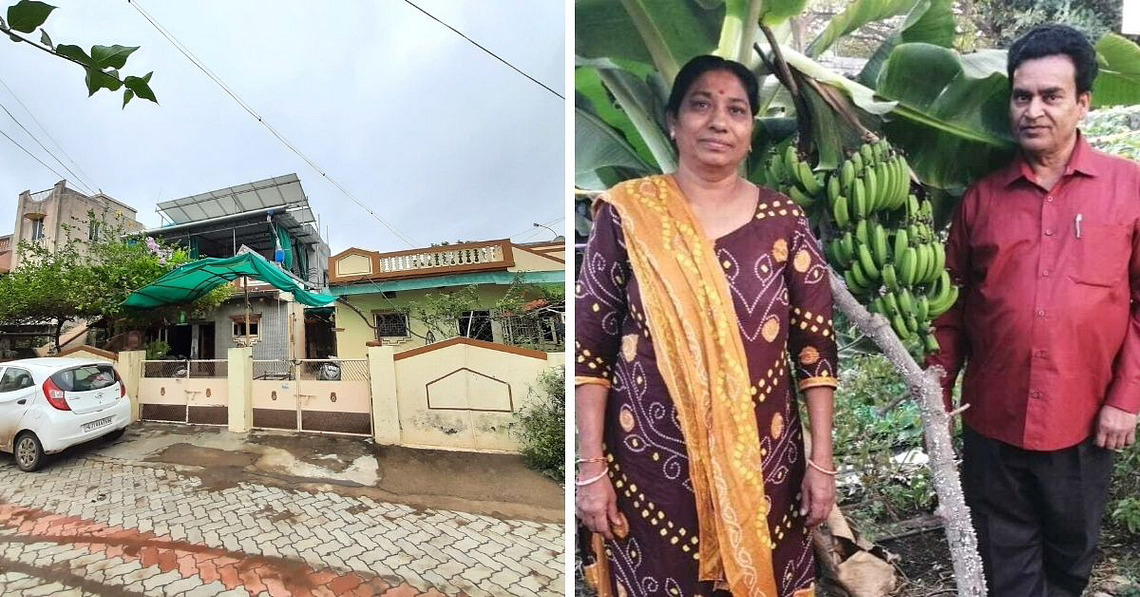
Kanubhai Karkare, an officer at the education department in Amreli has designed and built his sustainable house in 2000 for Rs 2.8 lakh.
At first glance, his house might look like any other concrete building that we see in our neighbourhood. But if you take a stroll around, you will notice an array of unique sustainable features the house has.
Unique methods:
- Built a 20,000-litre capacity underground water tank that stores rainwater during the monsoon. Another water tank of 8,000 litre capacity in the backyard serves the needs of gardening and other non-domestic needs. The excess rainwater is harvested and directed to recharge the groundwater table.
- Sewage water is recycled with the help of 2-feet-long vegetation beds with specific plant species that break down the complex elements present in the waste and decompose them. The recycled water is then used for kitchen gardening or other usages.
- The house has a 3 kW solar power unit that meets all its electricity needs and the surplus power is sent to the power utility company from where they earn Rs 10,000.
2. This house in Goa is fully powered by a hybrid solar energy system

For Madhusudhan Joshi, a professor at the Goa College of Pharmacy, building a sustainable house was not just a dream. It was also an effort toward putting into practice what he taught his students while taking lessons on renewable energy.
Thus in 2018, he built a sustainable house in Panaji, that’s fully powered by solar energy but using a unique hybrid system.
Unique methods:
- Unlike the usual on the grid and off-grid systems, a hybrid solar energy system was installed with the help of a Vasco-based company named Solar360. In the system, the energy generated from the sun is stored in a battery first. If there is surplus energy, it is exported to the grid and the government will offer compensation based on the number of units generated.
- Installed solar panels that could generate 11 kW of power on the roof. The energy generated was connected to four 15-Volt batteries, which further supplied energy to their home through an inverter.
The cost of installing the system is Rs Rs 5,80,000.
3. A Bengaluru house that’s rich in sustainable features

In 2019, Vishwanath, a Civil Engineer and Urban and Regional Planner, and Chitra who was an architect built their sustainable house at Vidyaranyapura in Bengaluru. The two-storeyed eco-friendly house was built using compressed different eco-friendly materials. Besides, there are several other features they have adopted, for minimising the usage of natural resources, like energy, water and materials.
Unique methods:
- The house is built using stabilised earth blocks, excavated from the site. Besides they have used sheets made from agricultural waste on certain parts of the roof, to prevent heating of the surface.
- For natural air and light, the house design focused on open arches instead of doors. Meanwhile, the basement windows at the ground level keep the indoor air cool plus the rooftop garden helps in cooling the house.
- Solar energy powers the house, bringing the electricity bills down by 1/4th in comparison to regular homes. As a backup, there is a biomass heater for heating water and cooking.
- Rainwater Harvesting (RHW) system helps store around one lakh litres of rainwater every year. Also called ‘Lifeline water’ for drinking and cooking, it comes from the clean catchment areas through the staircase room. There is also a recharge well which is connected to the stormwater drain.
- The house had two composting toilets which require no water. The waste collected after every use is covered with ash, and the microbes present on the toilet surface convert it into manure in a short period, which helps maintain the rooftop garden. And they use greywater for plants.
4. Bengaluru house harvests the sun & rain to be sustainable
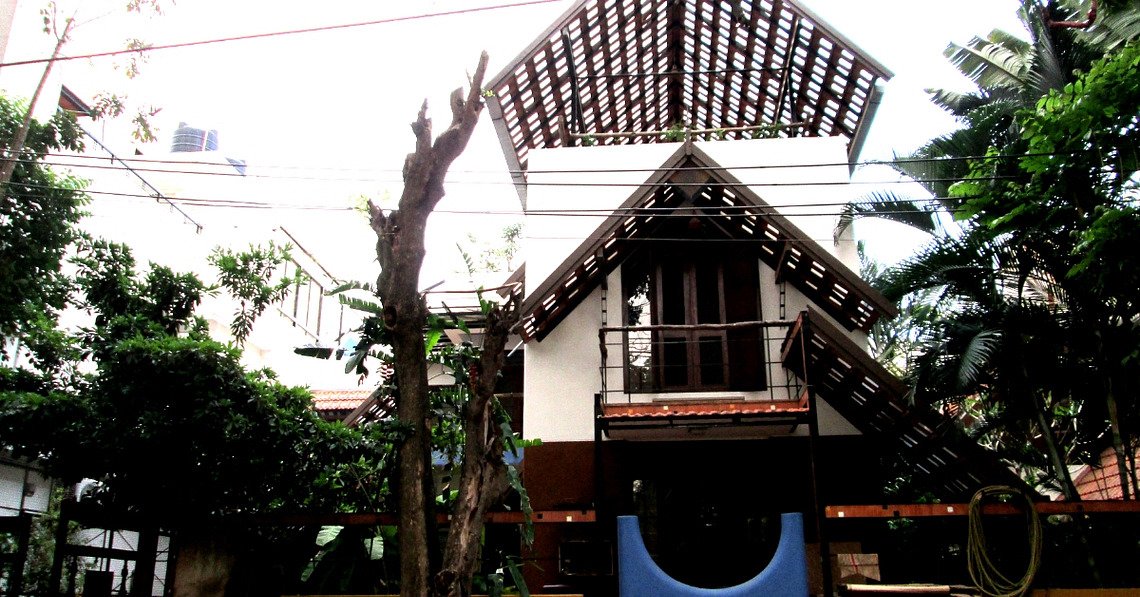
Rajesh and Vallari Shah, moved back to India from the US in 2007 aiming for a transition from a reckless lifestyle dependent on over-utilising resources to a more cautious and sustainable one. Thus they built a green home on the principles of love and an ahimsa (non-violent) way of life at Laughing Waters, Whitefield in Bengaluru.
Unique methods:
- Installed an 18-solar panel system with a capacity of 3KW. Apart from the microwave and the water pump rest of the appliances run on solar.
- The family save or reuse every single drop of water in their house. So, they adopted rainwater harvesting. Rainwater from the rooftop is sent via pipes, filtered through a sand bed filter and collected in three underground storage tanks with a capacity of 30,000 litres. This water is enough for nine months of the year, and for the next three months, they use the public water supply.
- Greywater is used for the garden downstairs. Since the family is chemical-free, the water from their showers is sent up to the terrace garden.
- The washing machine is a water-efficient front loader that uses 40 litres instead of 60 and the greywater after every wash is reused to flush toilets efficiently.
5. Surat house that’s consciously built & rooted in nature

It was always a dream for Snehal Patel, a Surat-based Mechanical Engineer, to build a house which is far from the hustle-bustle of everyday life. Finally, when he built his dream house, he decided to make it as sustainable as possible to have a life close to nature.
Unique methods:
- To reduce carbon footprint, they decided to go off-grid. So, a solar panel system with a capacity of 7.5 KW has been installed to meet the family’s energy needs.
- The solar panels are installed at an angle, and directly laid on the roof, so they absorb maximum solar energy. In the monsoons, the solar output may be less, and hence, a wind generator has been installed.
- A water tank on the rooftop stores rainwater filtered with a cloth filter and this is used in taps in the kitchens and bathrooms. Once the rooftop water tank is full, the water flows down through a channel and connects to another tank on the ground floor, which stores 2 lakh litres.
- On the other hand, greywater from washing machines is collected in a tank below the machine. With the help of a sump pump and a pipeline, this water is used in toilet flushes around the house.
- The house doesn’t have any sewage connection and reuses water from the bathrooms (washbasins and bathing area). An effective root zone filtration system has been set up using sand and plants like hyacinths, duckweed, and water lettuce. These plants help in cleaning the water.
- The blackwater from the toilets goes into settling tanks. Once the solids settle down, the water is filtered and used for watering in the garden. And, the solid material is turned into compost.
6. A Kerala house that uses traditional methods to eliminate hot air, reduce power bills
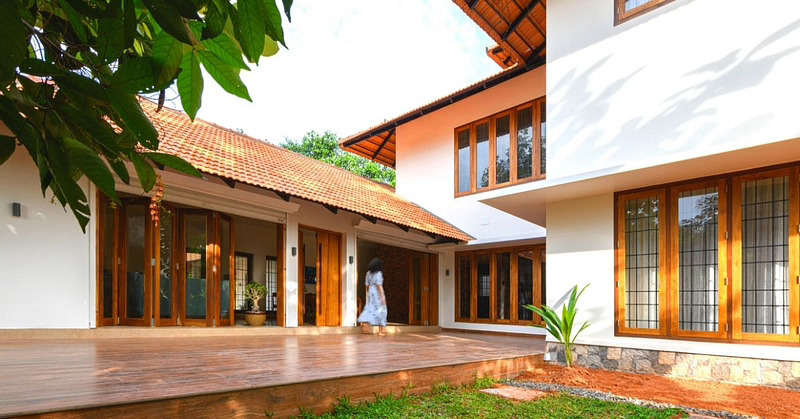
This Mangalore-tiled roof bungalow is inspired by Travancore’s traditional architecture with free-flowing spaces and grand windows, it is a perfect amalgamation of modern design techniques and vernacular concepts of natural light ventilation.
Unique methods:
- The house has heightened ceilings and wall-sized windows.
- A wind tower is constructed on a physics principle called ‘stack effect’ alongside the staircase. The concept uses temperature differences to move air. Hot air rises because of its low-pressure characteristics. The tower with four openings captures this hot air and releases it outdoors.
- The exhaust fans are placed between the toilet and the room so that they can suck out the hot air along with the smell.
- The roofs extend up to 1.5 metres to each side of the structure unlike the usual shading of 0.6 metres. The protruding roofs give enough shade to the house thus preventing direct penetration of sunlight.
- Mangalore tiles are used on the roof which have immense insulation capacity, thus keeping energy consumption in check.
7. This unique mud house in Faridabad has no ACs
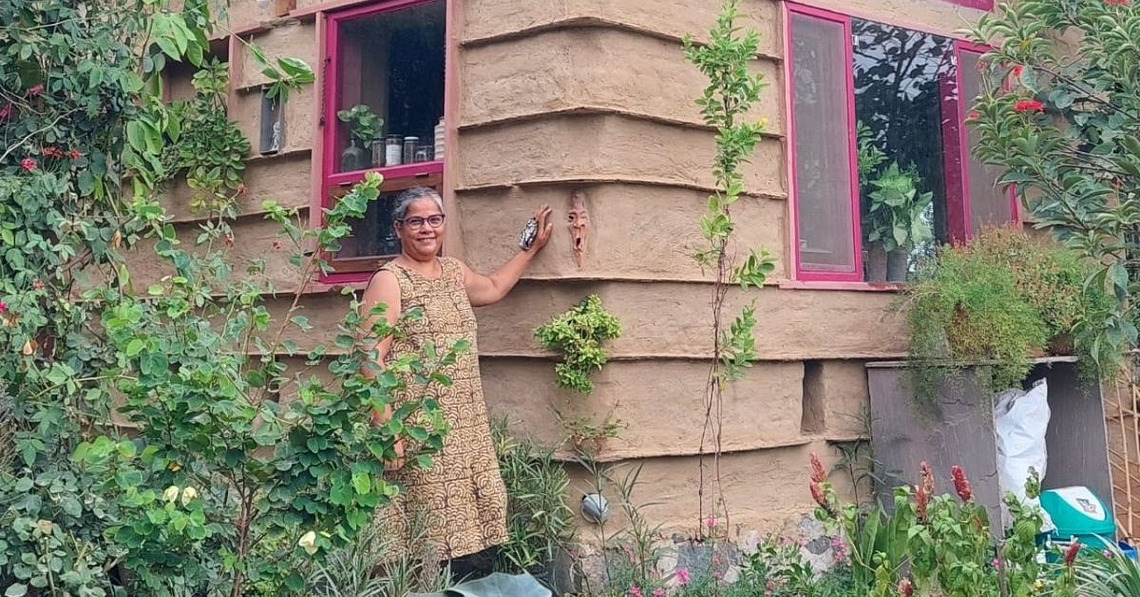
Veena Lal, who runs an NGO named Karma Marg in Faridabad, constructed her eco-friendly home with the help of a young Mumbai-based architect named Amol Mannekar. Her 1,800 sq ft sustainable mud house consumes very little energy and has no water connections that lead to wastage.
Unique methods:
- The outer structure of the building has been raised using sun-baked bricks that are plastered with mud. This provides an added layer of insulation to the house and keeps it cool at all times.
- The roof has been lined with locally-made red clay tiles and the flooring has been done with large stones found in the surrounding areas of her home.
- They use a dry toilet with no usage of water or flushing.
- The bathroom situated within the house has an open structure so that during the day, there is no need for light. To ensure there is no wastage of water, the architect has constructed space to plant trees that purify the water and improve the groundwater level.
- Her NGO, located adjacent to her house, is fully powered by solar energy. After constructing her home, she integrated the system of both buildings and powered all the amenities using solar power.
8. A zero-waste, solar Tamil Nadu home saves 70 per cent energy monthly
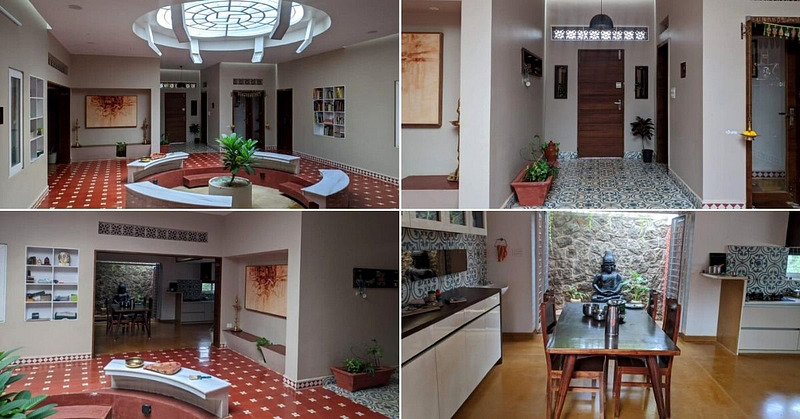
Balasunda Kaushikan, a Bengaluru-based architect, built his dream home in his village in Theni, Tamil Nadu, based on the zero-waste concept. The sustainable house was built for Rs 55 lakh. Besides, his house employs several sustainable practices that reduce energy consumption and water wastage.
Unique methods:
- The biodigester tank degrades and converts human waste into the water which is used for gardening purposes, and the methane gas produced is used in our kitchen.
- A rainwater harvesting system and a rainwater recharge well are also in place. The rainwater collecting well has a capacity of 10,000 litres and there is another well adjacent to the tank to collect the excess rainwater that overflows from it, which in turn helps in recharging the groundwater levels.
- A big courtyard right in the middle of the house helps in lighting the interiors with natural light as well as in keeping the house cooler.
- They use solar energy for everything except for a few heavy-duty appliances like the washing machine, mixer grinder, etc.
Edited by Yoshita Rao
This story made me
- 97
- 121
- 89
- 167
Tell Us More
We bring stories straight from the heart of India, to inspire millions and create a wave of impact. Our positive movement is growing bigger everyday, and we would love for you to join it.
Please contribute whatever you can, every little penny helps our team in bringing you more stories that support dreams and spread hope.






